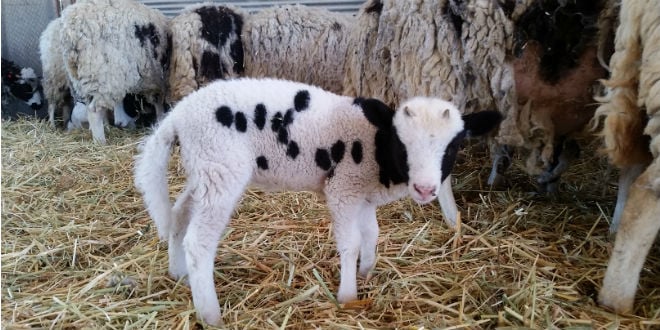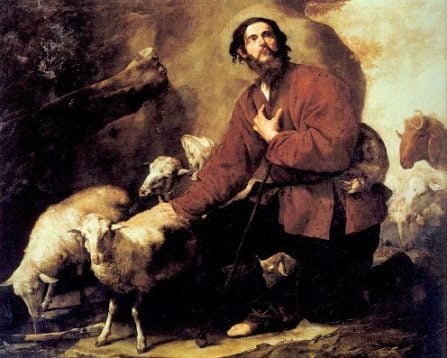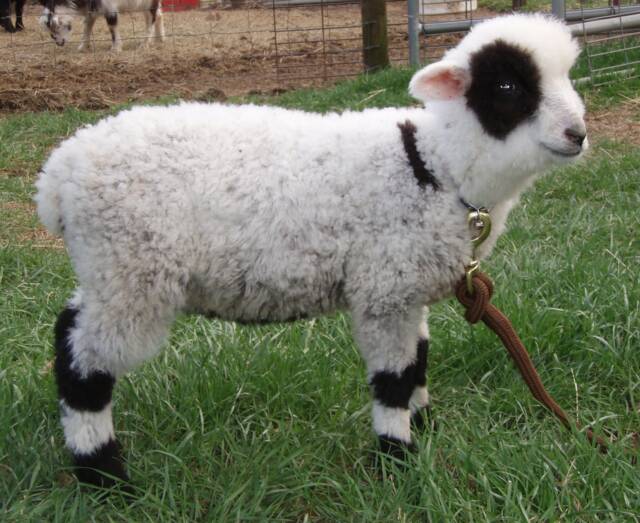And it came to pass at the time that the flock conceived, that I lifted up mine eyes, and saw in a dream, and, behold, the he-goats which leaped upon the flock were streaked, speckled, and spotted. (Gen. 31:10)
This week’s Torah reading, Vayeitzei (Gen. 28:10-32:3) talks about three kinds of sheep: streaked, speckled, and spotted.
Streaked sheep (“akudim”) were ankle-ringed.
They looked as if their ankles were bound together with a black rope. Hence the name—”akidim” (Hebrew world for streaked, “akud” means bound as in “Akeda”—binding of Isaac).

Speckled Sheep
Speckled sheep (Heb. “nekudim” from sing. “nakod”.) were sheep with black dots.

Spotted Sheep
Spotted or flecked sheep (Heb. “berudim“) were blotched.
What is the significance of these streaks, speckles and blotches that the Torah devotes so much attention to them? The masters of Kabbalah teach that these are metaphors for various spiritual worlds in which Divine Emanations, Sephirot, are arranged in different ways.
Rabbi Chaim Vital writes in Etz Chaim that the ten Divine Emanations—sephirot—exist in three stages: Akudim (Ringed), Nekudim (Speckled) and Berudim (Spotted).
The highest of these worlds is the world of Akudim. The streaks on the feet of Jacob’s sheep are also called “akudim.” As mentioned above, this word means “bound.” This is the world where sephirot are bound together. They are not differentiated yet. That is why they are called at this stage “hidden” sephirot. There are ten lights (Heb. “ohrot“), but only one vessel (Heb. “kli“). Ten lights are “tied” together in one vessel. The world of Akudim is identified with Adam Kadmon—Primordial Man.
The second world is the world of Nekudim. Nekudim are dots. Speckled sheep are called “nekudim,” because of the black dots on their coat of wool. This is the world where sephirot are represented by dots—they are already separated into 10 individual sephirot and have self-identity, but they cannot relate to each other. There are ten lights (ohrot) and ten vessels (kelim). But there is no interinclusion of the sephirot—each sephirah stands on its own—like a separate dot. This world is identified with the World of Tohu—the world of Chaos, where the breaking of the vessels (shevirat hakelim) occurred.
The third world, the world of Berudim, is where sephirot are reunited and interincluded. Each of the ten sephirot contains all ten subsephirot in a fractal configuration. The specific configurations of sephirot are called Partzufim (pl. of Heb. “partzuf“). These groupings of Sephirot are symbolized by the blots on the spotted (flecked) sheep of Jacob, where separate dots merge into large blotches of darker color. The world of Berudim is identified with the world of Tikun—the World of Order and Rectification (fixing, correction, reparation or mending), which is our Universe.
To me, three types of Jacob’s sheep—stripped, speckled and spotted—is a metaphor for three views on the nature of elementary particles. After all, if sephirot are building blocks of the spiritual world, elementary particles are building blocks of the physical world.
Historically, as the theory of elementary particles was first developed, particles were viewed as zero-dimension points. Zero-dimension, meaning they lack width, depth and height as infinitesimally small dots with no dimensions to them. Physical properties are assigned to these point-like particles. While it is difficult to imagine any physical object that takes up no space, elementary particles, according to particle physics, take up no space although they possess other physical characteristics as energy, momentum, spin, etc. This view is still held by many particle physicists. Clearly, speckled sheep of Jacob can be viewed as a metaphor for point-like elementary particles. Conversely, elementary particles in this point-like paradigm is a good physical metaphor for the sephirot in the world of Akudim.

Particle as Field Excitation
As quantum field theory was being developed, an elementary particle began to be viewed as an excitation in a field or, simply speaking, blotches of the field. For example, a photon is viewed in quantum field theory as an excitation of the electromagnetic field. A gluon is an ecxitation of the field carrying strong nuclear forces. W+, W−, and Z bosons are excitations in the field carrying weak force. Higgs boson is an excitation in the Higgs field, a yet-to-be-discovered graviton is thought to be an excitation of the gravitational field, etc. Once again, spotted sheep of Jacob can be viewed as a metaphor for quantum field theory as the blotches on sheep coat represent blotches of the physical field that are elementary particles. And conversely, quantum field theory provides good physical metaphor for sephirot as they exist in the world of Berudim.

Vibrating Quantum String
Lastly, streaked sheep of Jacob, are a metaphor for quantum strings. String theory envisions elementary particles as tiny strings vibrating in nine dimensions, six of which are curled up and, therefore, invisible to us. The streaks on the ankles of the sheep actually look like strings that tie the ankles together. Moreover, just as sephirot of the world of Akudim are called “hidden” sefirot, so too strings vibrate in mostly hidden dimensions, which are the extra-dimensions above our three spatial dimensions—length, width and height. Just as in the world of Akudim, ten lights coexist in one vessel, String Theory envisions elementary particles as various notes corresponding to different frequencies of a vibrating string. Clearly, strings provide excellent physical metaphor for the sublime world of Akudim.
So, was our forefather Jacob a simple shepherd, expert kabbalist or a theoretical physicist working out String Theory while breeding sheep of Laban? You be the judge.



Leave A Comment